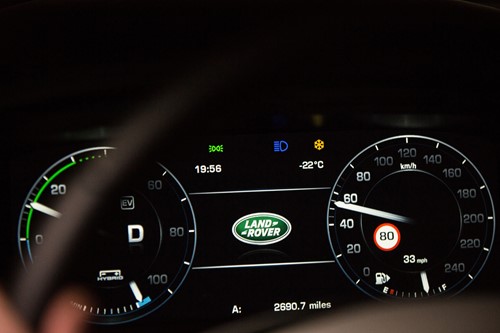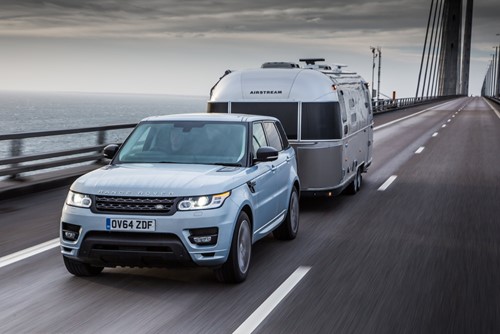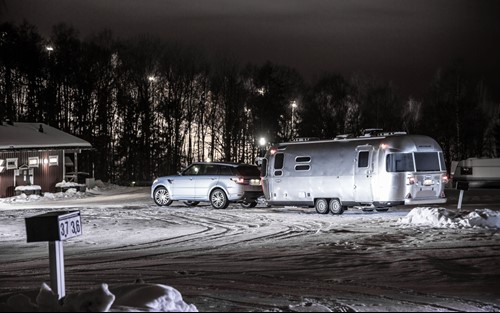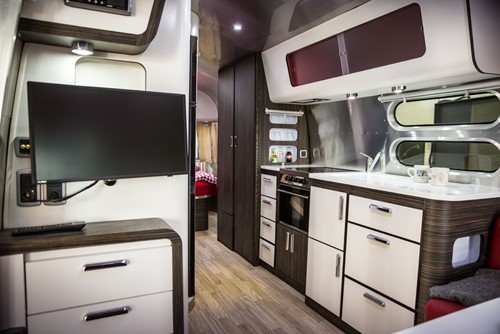Article by: Peter Adams
It’s 7pm on a February evening, and the temperature is now resolutely below -20ºC at the border of the Arctic Circle. The invisible line is where one of the most naturally hostile and inhospitable places on the planet begins – but much more importantly it also marks the conclusion of our 2500-mile adventure from Jaguar Land Rover’s Gaydon factory, via Airstream Europe in Germany, to this point. The end of the #HybridAdventure, designed to push the car and our luxury Airstream 684 trailer to their limits.
Meanwhile, we all cough into our celebratory mugs of tea – steam at -20 hurts when you inhale it as you go for another slurp.

It was a long journey spent with the same two people – one my boss, one a photographer – and, although not the principal aim, highlighted the joy and the freedom of caravanning.
In little over a week, we drove from England, into France, through Belgium – glancing across the southern tip of Holland – into Germany, north into Denmark, and finally Sweden. We drove through fog, sleet, rain and snow – but mostly just beautiful sunshine.
With driving somewhere, rather than flying, you gain a perspective of distance, and can see the landscape changing. Northern Germany and Denmark are relatively flat, but then Denmark wakes you up with three magnificent bridges – including the famous Øresund Link bridge – between its mainland, islands and eventually Sweden. And if the sight of them doesn’t wake you up, the pummelling side winds will.

From Denmark into Sweden, the colourful wooden clapboard buildings begin – alas, the hilarious signs for ‘infart’ (without the Germans’ party-pooping ‘h’ in ‘fahrt’) come to an end.
Heading further north into Sweden, beyond the historic and tightly streeted city of Gothenburg, the huge forests begin. Pines soar high either side of the road, with great clearings of vast rolling countryside beyond. Sweden looks and feels big and open – in the wilderness there are reindeer and moose, and in the warmer months bears and even wolverines.
The temperature stayed much the same between Stockholm, where we fitted studded tyres to our vehicles, and Umea further north. But it was when we cut inland that the temperature plummeted and the roads became more treacherous.
Driving on ice isn’t too bad – it’s consistent. What’s worse is when it’s patchy. And that’s not so fun when you’re towing.
Eventually, the roads became just ice. Impossible to walk on, yet somehow fine to tackle with a car.
By the time we reach the Arctic Circle, we feel like ice-driving experts. Albeit extremely cautious and slow experts. And as we stand there, spluttering into our steaming cups of tea, we share satisfied yet wearisome nods of approval.

We look up to the sign for the Arctic Circle. The parish council budget must have been particularly low in the year the locals bought the sign, because it’s unbelievably, incredibly, crushingly disappointing. It’s just a road sign with Arctic Circle written in different languages. But we’re still pleased – and we’re still warm, and able to have a brew.
A colleague manages to take a slurp of tea and stops coughing for a moment. The memories of those 2500 miles, on asphalt and ice and snow and slush, driven in the supreme luxury of the Range Rover Sport Hybrid, and cossetted by our Airstream, a boutique hotel room on wheels, all come to mind: ‘We’ve done it, chaps.’

Find out how the team began their journey.


